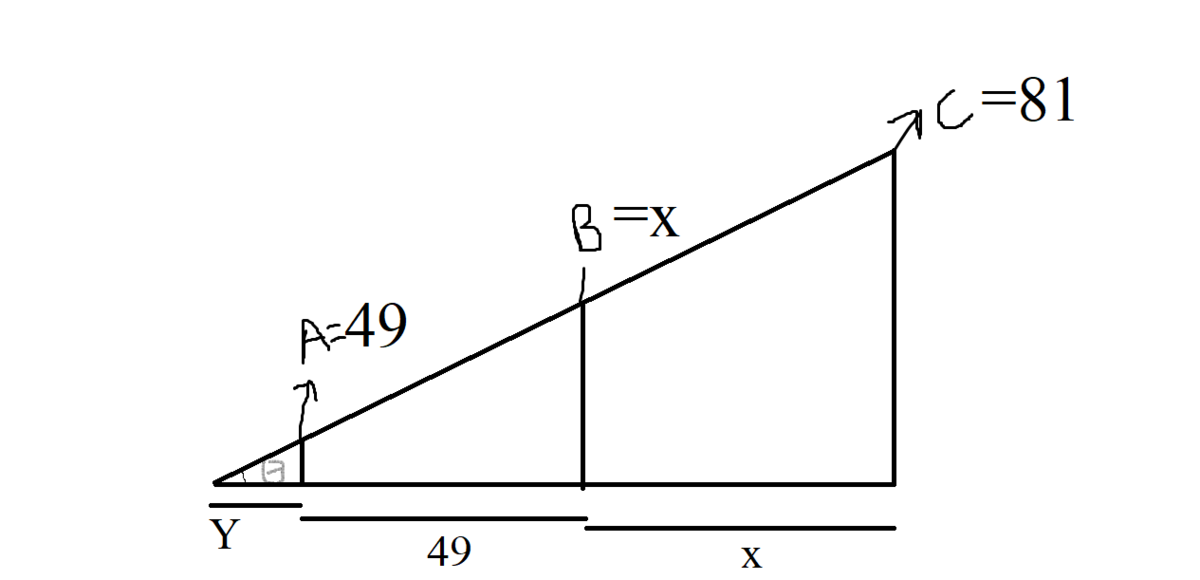Up, up and away
Suppose 2 0 1 5 people of different heights are arranged in a straight line from shortest to tallest such that
(i) the tops of their heads are collinear, and
(ii) for any two successive people, the horizontal distance between them is equal to the height of the shorter of the two people.
If the shortest person is 4 9 inches tall and the tallest is 8 1 inches tall, then how tall is the person at the middle of the line, (in inches)?
The answer is 63.
This section requires Javascript.
You are seeing this because something didn't load right. We suggest you, (a) try
refreshing the page, (b) enabling javascript if it is disabled on your browser and,
finally, (c)
loading the
non-javascript version of this page
. We're sorry about the hassle.
3 solutions
Nice problem :)
Conclusion : geometric mean of height of tallest & shortest is equal to height of Middle person.
It is actually close to the average of 49 and 81.
Let the positions of the 2015 people be x 0 , x 1 , ⋯ , x 2 0 1 4 , and their heights be y 0 , ⋯ , y 2 0 1 4 . By hypothesis, it follows that y 0 = 4 9 , y k = x k + 1 − x k for k = 0 , ⋯ , 2 0 1 3 , and y 2 0 1 4 = 8 1 . Further, the ( x i , y i ) 's satisfy a linear equation of the form y i = m x i + b for i = 0 , ⋯ , 2 0 1 4 . Without loss of generality, we may assume x 0 = 0 , so that b = 4 9 . In particular, we find the sequence ( x k ) k ≥ 0 satisfies the recursion x k + 1 = ( m + 1 ) x k + 4 9 . Define the generating function f ( z ) = k = 0 ∑ ∞ x k z k . Then, the recursion implies the generating functional equation f ( z ) ( z 1 − ( m + 1 ) z ) = 1 − z 4 9 . Solving this equation, we find that f ( z ) = m 4 9 ( 1 − ( m + 1 ) z 1 − 1 − z 1 ) . Extracting coefficients, we see that x k = m 4 9 ( ( m + 1 ) k − 1 ) for k = 0 , 1 , ⋯ , 2 0 1 4 . Now, we substitute y 2 0 1 4 = 8 1 to obtain 8 1 = m 4 9 ( ( m + 1 ) 2 0 1 4 − 1 ) m + 4 9 , which implies that ( m + 1 ) 1 0 1 2 = 7 9 . The height of the middle person is given by y 1 0 1 2 = m 4 9 ( ( m + 1 ) 1 0 1 2 − 1 ) m + 4 9 , which after simplification becomes y 1 0 1 2 = 4 9 ( m + 1 ) 1 0 1 2 = 6 3 .

- Here it doesn't matter how many people are standing in the line given the height of the smallest and the tallest and the heads are are collinear.
- So now using the above figure we can make 3 simple equations which are shown below:
- Now equating the values from the above equations we get the following:
Sir in second eq how you multiple the 81 with x
Look at any three successive people in the line. Let A , B , C be the tops of their heads in sequence, and let D , E , F be the bottoms of their respective feet. Let the horizontal line through A intersect B E at P , and let the horizontal line through B intersect C F at Q . Then Δ A P B and Δ B Q C are similar, and so
∣ B E ∣ ∣ C F ∣ = ∣ B Q ∣ ∣ C F ∣ = ∣ B Q ∣ ∣ C Q ∣ + ∣ Q F ∣ = ∣ B Q ∣ ∣ C Q ∣ + 1 = ∣ A P ∣ ∣ B P ∣ + 1 = ∣ A P ∣ ∣ B P ∣ + ∣ A P ∣ = ∣ A P ∣ ∣ B E ∣ .
Thus the heights of any three successive people are in geometric progression, and thus the heights of all 2 0 1 5 people are in geometric progression.
Now the height h n of the n th person is given by the formula h n = h 1 r n − 1 for some real number r > 1 . We are given that h 1 = 4 9 inches and h 2 0 1 5 = 8 1 inches, so
8 1 = 4 9 r 2 0 1 4 ⟹ r = ( 4 9 8 1 ) 2 0 1 4 1 ,
and thus h 1 0 0 8 = 4 9 ∗ [ ( 4 9 8 1 ) 2 0 1 4 1 ] ( 1 0 0 8 − 1 ) = 4 9 4 9 8 1 = 4 9 ∗ 7 9 = 6 3 inches.